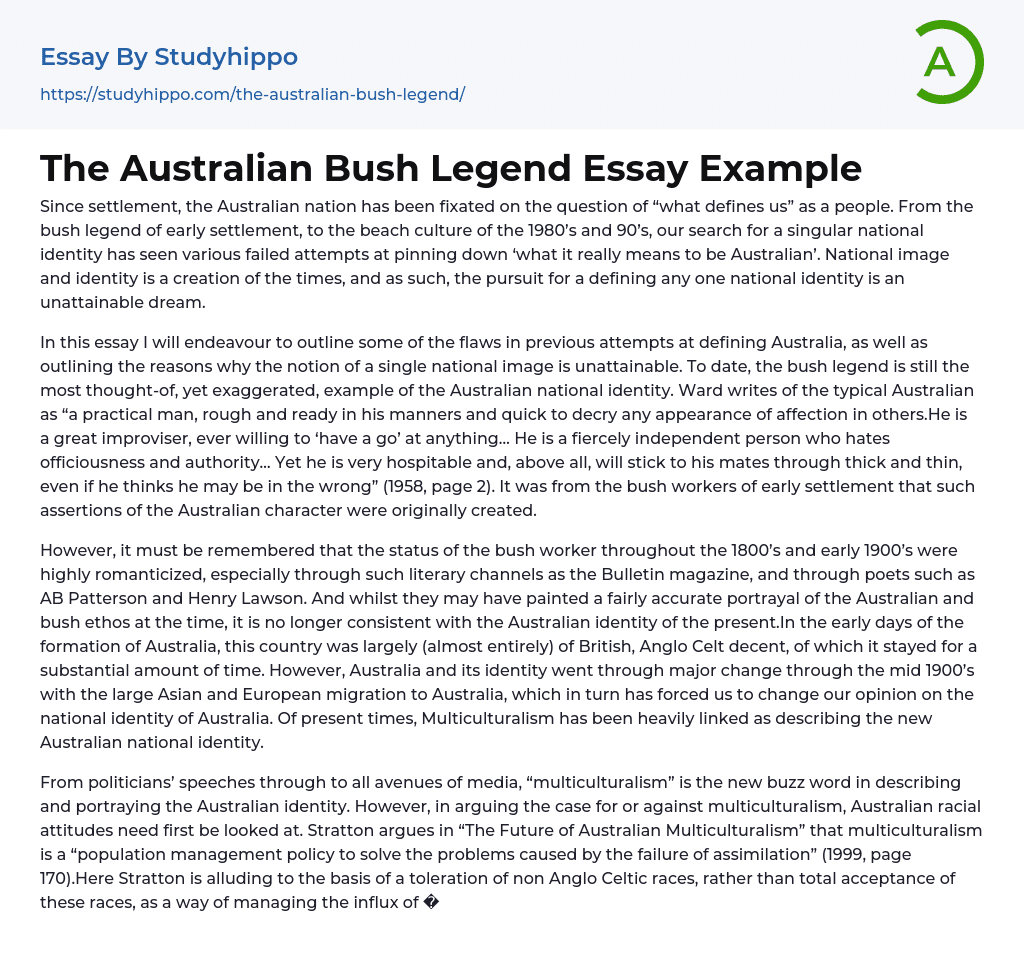Since settlement, the Australian nation has been fixated on the question of “what defines us” as a people. From the bush legend of early settlement, to the beach culture of the 1980’s and 90’s, our search for a singular national identity has seen various failed attempts at pinning down ‘what it really means to be Australian’. National image and identity is a creation of the times, and as such, the pursuit for a defining any one national identity is an unattainable dream.
In this essay I will endeavour to outline some of the flaws in previous attempts at defining Australia, as well as outlining the reasons why the notion of a single national image is unattainable. To date, the bush legend is still the most thought-of, yet exaggerated, example of the Australian national identity. Ward writes of the typical
...Australian as “a practical man, rough and ready in his manners and quick to decry any appearance of affection in others.He is a great improviser, ever willing to ‘have a go’ at anything… He is a fiercely independent person who hates officiousness and authority… Yet he is very hospitable and, above all, will stick to his mates through thick and thin, even if he thinks he may be in the wrong” (1958, page 2). It was from the bush workers of early settlement that such assertions of the Australian character were originally created.
However, it must be remembered that the status of the bush worker throughout the 1800’s and early 1900’s were highly romanticized, especially through such literary channels as the Bulletin magazine, and through poets such as AB Patterson and Henry Lawson. And whilst they may have
painted a fairly accurate portrayal of the Australian and bush ethos at the time, it is no longer consistent with the Australian identity of the present.In the early days of the formation of Australia, this country was largely (almost entirely) of British, Anglo Celt decent, of which it stayed for a substantial amount of time. However, Australia and its identity went through major change through the mid 1900’s with the large Asian and European migration to Australia, which in turn has forced us to change our opinion on the national identity of Australia. Of present times, Multiculturalism has been heavily linked as describing the new Australian national identity.
From politicians’ speeches through to all avenues of media, “multiculturalism” is the new buzz word in describing and portraying the Australian identity. However, in arguing the case for or against multiculturalism, Australian racial attitudes need first be looked at. Stratton argues in “The Future of Australian Multiculturalism” that multiculturalism is a “population management policy to solve the problems caused by the failure of assimilation” (1999, page 170).Here Stratton is alluding to the basis of a toleration of non Anglo Celtic races, rather than total acceptance of these races, as a way of managing the influx of “new” Australians. In Jayasuriya’s writing “The Asianisation of Australia? Some Facts About The Myth” he goes even further to Stratton to argue that “while there has been a community-wide acceptance of the need for a non-discriminatory immigration policy, there has concurrently been a fairly consistent expression of negative attitudes towards Asian immigration” (1999, page 75).
Here Jayasuriya is writing of the attitudinal issues that white Australians hold towards the Asian migrants of this
country. It can therefore be argued that as a consequence of these negative attitudes towards specific races within Australia, that acceptance of multiculturalism as a national identity would be widely rejected by the Australian public. It is also important, when questioning multiculturalism as a national identity, to look into Australia’s governmental policies on multiculturalism in Australia.Policies such as the “White Australia Policy” have been the direct product of the negative attitudes of white Australians towards the multiculturalism of Australia. Whilst this policy failed (not for lack of trying), it raised questions of white Australians moral attitudes towards having a multicultural Australia.
The introduction of “official multiculturalism” in the 1970’s by the Australian government (after the failure of the white Australia policy) was simply a new way to try and assimilate new migrants to the Australian way of life.Stratton writes that “In the Australian circumstance, cultural pluralist multiculturalism… was adopted by the Fraser government in such a way as to contain cultural difference” (1999, page 170). Here, it is obvious that Stratton believes that by “containing cultural difference” we are simply tolerating, but not necessarily accepting, the differences between white and migrant cultural differences.
- Australian Culture essays
- Migration essays
- Human Migration essays
- Illegal Immigration essays
- Immigrants essays
- Refugee essays
- Afghanistan essays
- Africa essays
- America essays
- Asia essays
- Australia essays
- Caribbean essays
- City essays
- Developing Country essays
- Dubai essays
- Earthquake essays
- Europe essays
- Fracking essays
- Georgia essays
- Middle East essays
- Natural Disaster essays
- New Zealand essays
- North Korea essays
- South Korea essays
- Thailand essays
- Travel essays
- Abraham Lincoln essays
- Andrew Jackson essays
- Barack Obama essays
- Bill Clinton essays
- Donald Trump essays
- Franklin D. Roosevelt essays
- George W. Bush essays
- George Washington essays
- James Madison essays
- John F. Kennedy essays
- Lyndon B. Johnson essays
- Richard Nixon essays
- Theodore Roosevelt essays
- Thomas Jefferson essays
- Vice President essays
- Abortion essays
- Abuse essays
- Animal Rights essays
- Animal Testing essays
- Assault essays
- Bullying essays
- Controversial Issue essays
- Crash essays
- Cyber Bullying essays




